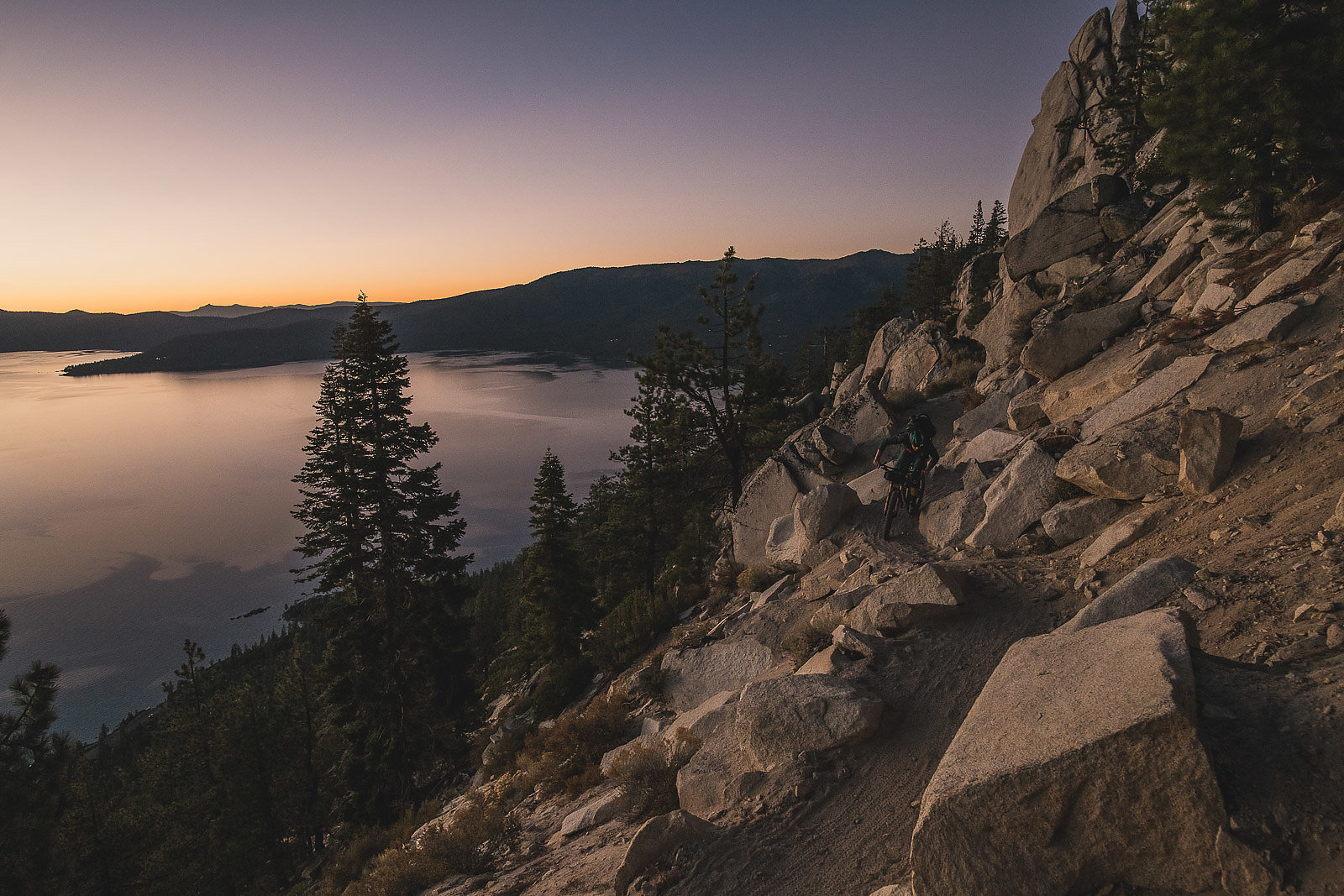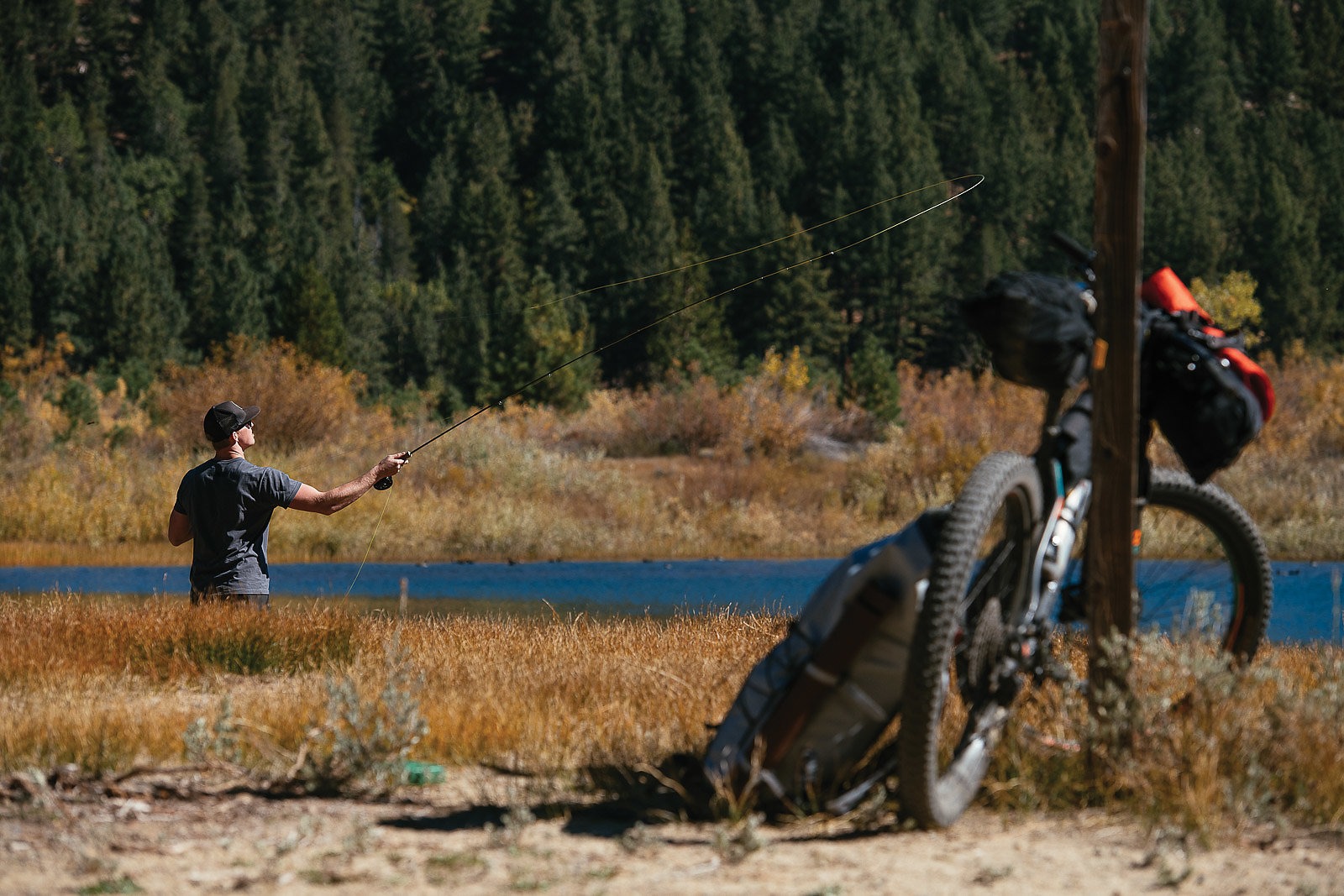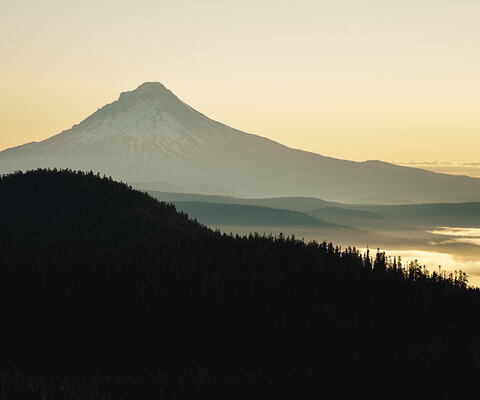
Welcome to the Gong Show Conquering Catastrophe on the Tahoe Rim Trail
Words by Jann Eberharter | Photos by Margus Riga
The face-plant comes out of nowhere.
Perhaps because I can barely see my front wheel over my handlebar bag, or maybe because gravity takes a quicker-than-usual pull on my unwisely heavy backpack. Either way, the ground seems to rush toward my face with unusual speed. I only have time to hope I don’t lose teeth before slamming into the dusty singletrack.
This bloody tumble may be particularly brutal, but we’ve been plagued by chaos since we started riding yesterday—45 minutes into our trip, to be exact, when Kevin’s derailleur exploded.
Despite its frustrating persistence, this logistical mess didn’t arise from lack of planning. Enduro racer and good friend Stan Jorgensen had been trying to put together a bikepacking and fly-fishing trip for the better part of a year. After thorough deliberation, several relocations and a late-summer shoulder blowout for Stan, we settled on a three-day adventure on California’s Tahoe Rim Trail in early October.
In its entirety, the Rim Trail completely circumnavigates Lake Tahoe, but a majority of the western portion is closed to bikes. We’d decided to ride the section connecting Mt. Rose Ski Area to Freel Peak, from which we’d drop into the small town of South Lake Tahoe. Along the way, we’d make stops at Marlette, Spooner and Star lakes, all with fish but only the latter two legally in season, ideally augmenting our other bare-bones rations with trout delicacies.

That had been the plan, at least. But as I slowly push myself up, worried I’ll find teeth on the ground, an old Yiddish proverb runs through my head: “We plan, God laughs.”
When a trip starts multiple hours behind schedule, it sets a particular tone. Our goal was to begin pedaling from the Mt. Rose Highway, which connects Reno, NV to nearby Lake Tahoe, at 7 a.m., arriving even earlier to pack our final essentials. Then we’d strike off into the early morning sun, cruising the ridgeline that borders the eastern side of the lake.
It’s 1 p.m. when we arrive at the trailhead, and the sun is a raging ball of fire directly above our six-hour-tardy heads. Since we’re already exceedingly late, we all indulge in a beer after I hang up the phone with the Nevada Department of Wildlife. We’d remembered a few hours before that we’d need fishing licenses, and securing them was one of the last-minute tasks that kept us from our crack-of-dawn deadline.
Our group had coalesced at 7 a.m. that morning, but in a grocery-store parking lot in Incline Village. Freehub publisher Brandon Watts, photographer Margus Riga, Canadian all-star Kevin Landry, and I had made the 14-hour drive from the Pacific Northwest the day before, and upon rendezvousing we exchanged hugs and handshakes with Stan. After a second round of coffees, we jumped into a high-stress, low-speed shopping and packing spree, which wound down about noon. Then it was on to the trailhead for one more round of buckle tightening and gear shuffling, my call to the Department of Wildlife, and the last roadside beer.

We finally kicked off into the midday heat. By the time we start sweating—about three minutes in—it had become obvious our collective subconscious was on a much different schedule than we’d hoped to be.
At 8,000 feet, our average cruising elevation, there is roughly 76 percent of the oxygen available at sea level. Such elevations mean beautiful views, fresh breezes and expansive singletrack, but when the entirety of your crew is based in towns with altitudes in the double-digits, that 76 percent becomes a brutal number. It feels like breathing through a straw, and after a few hundred feet of climbing, we were all gasping. Unfortunately—or fortunately, considering the time of day—nothing could be done about it, save for spending a few more days acclimatizing. That was not an option, so we put our heads down and suffered toward the ridge above.
Luckily, we topped out after only 20 minutes, and were greeted by famously blue Lake Tahoe. With a maximum depth of 1,644 feet, it is deeper than the Empire State Building is tall, and holds 39 trillion gallons of water. From our perch, tiny boats drew swirly white lines in the water far below. Despite the altitude, we decided there is some consolation: The view didn’t suck.
In Nevada, it’s almost impossible to tell up from down because somehow you’re always pedaling.
The elevation was to our advantage as we began the drop from 8,700 feet to Spooner Lake, at just above 7,000. We realized quickly Tahoe’s definition of “downhill” is much different than ours at home. There, we tend to go straight up, then straight down. In Nevada, it’s almost impossible to tell up from down because somehow you’re always pedaling.

Thankfully, this is also an advantage when it comes to mileage. In the Pacific Northwest, five miles can be a big day. We were hoping to cover about 20 miles each day, a reasonable goal considering that, well, you’re always pedaling.
The Tahoe Rim Trail may not have been built with bicycles in mind, but it rides like it was. While a few sections do resemble granite staircases—fairly standard for the area—most is friendly to even moderately experienced riders. The grading is reasonable, and aside from a few technical moves, the trail doesn’t require anything special in the way of a bike other than a front shock and working derailleur.
The latter requirement became an issue a mere five miles and 45 minutes from the car, with our first mechanical failure of the trip. Actually, it was more of a casualty than a failure. I rounded a corner to see Kevin’s drivetrain scattered along the trail, an irreparable mess of chain, pulleys and cables. Luckily, Kevin had a second bike in the car, and as he and Brandon returned the limping bike back to the trailhead, the rest of us took naps, ate snacks and threw pebbles at various inanimate objects while the sun descended on the horizon. Our subconscious, which wasn’t in any sort of hurry, had won again.
It was a victory with consequences, however. Late or not, we still had to reach our planned campsite, so when Kevin and Brandon returned, we vowed to stop only to regain our breath. Few motivators are more effective than a good section of trail, and so when we merged onto the Flume Trail three miles later, we felt a new surge of energy.

The Flume Trail is a local classic, built on an old waterway from the damming of nearby Marlette Lake in 1873. The contraption, a staircase of wooden boxes and linked pipelines, fed water to a glut of mines in the surrounding area, which sprung up in the late 1800s during a gold boom. In the ensuing decades, the flume’s water rights transferred to a private corporation intending to build a missile-testing site, before finally being taken over by the State of Nevada. In the mid-1980s, led by local mountain bike advocate Max Jones and Nevada State Parks, the Flume Trail was repurposed for recreation and opened to the public.
Due to its origins, the Flume Trail varies from the width of a logging road to the width of modern-day handlebars, with the majority running along a steep cliff—no-fall-zone steep. But along with the intimidating features comes some spectacular views of Lake Tahoe.
As we cruised (and occasionally walked) the Flume Trail, the sun dropped behind the horizon and silhouetted the peaks with a brilliant blend of yellows, pinks and purples. By the time we reached the turnoff for Marlette Lake, all but the last rays of light were gone, leaving us to pedal to the campsite in the dark. We made dinner by headlamp before wandering off to our sleeping bags, watching as a near-full moon rose into the dark sky, floating at the leisurely pace of the universe.
It’s tough to obey alarms when neither the sun nor another soul is up, but few things will wake you more effectively than bombing five miles down a dusty dirt road. It’s more shocking than the two cups of instant coffee we drank with breakfast.

The road dumped us out at Spooner Lake, the first fishable body of water on the trip. Late morning isn’t ideal for fly-fishing, but Stan and I debated flies before spending the next two hours trying our own methods. I went for a dry fly; he went for every variety and combination he could dream up from his fly box. Neither worked.
As the classic saying goes, “That’s why they call it fishing, not catching.” Our smiles at finally tossing a few first casts slightly overshadowed the disappointment of our failure—until we started riding. That excitement disappeared quickly as we started the 1,800-foot climb back toward the ridgeline.
When we topped out, we found the wind was howling and temperatures had dropped enough that we barely paused for a rest. Instead we cranked along, trying to maintain our 20-mile-a-day pace. A few hours into the day, and we were doing well. That is, until I put my face into the ground.
The day before, I’d joked that the trip was a “gong show,” and while my crash is right in line with that trend, it’s more painful than I would prefer. It’s also bloodier, and after recovering my wits and verifying I have all my teeth, I hop on my bike and groggily catch up to Stan and Kevin.

Upon further inspection, they tell me I have quite the hole in my chin, stuffed with dirt and most likely stitches-worthy. Thankfully, we aren’t far from Heavenly Mountain Resort’s Summit Village, and it’s an easy decision to head that way for medical care and alcoholic self-medication. With a 12-pack as our new goal, we pedal rapidly toward civilization.
It’s not as bad as I expected, at least not bad enough to make us pass up a barbecue feast at an adjacent restaurant.
When we stop at the convenience store, I head straight to the bathroom to assess my shredded face situation. It’s not as bad as I expected, at least not bad enough to make us pass up a barbecue feast at an adjacent restaurant.
With a good buzz going and my wounds mixed with a healthy dose of barbecue sauce, Brandon—whose job description evidently includes “overseer of all mishaps”—and I catch an Uber to the emergency room in South Lake, while the rest of the crew checks into a hotel. After I mumble sorry for derailing the trip, they respond with unanimous “thank yous.” We’ve only been out one night, but the ensuing miles have been rough, and they’re all overjoyed at the prospect of a real bed It’s not the encouragement I expected, but I’m glad everyone is happy.
Fifteen stitches and six hours later, my alarm goes off. It’s 5 a.m., and the last thing I want to do is ride bikes. But the past two days have left us far short of our destination, and so we decide to extend the trip by another day. It’s not my favorite idea, but at least the afternoon’s goal of Star Lake is only a mellow, nine-mile climb away.

The trail leads directly out of the village and through Heavenly’s trimmed ski runs, before winding behind the resort and up and over the Nevada-California border. Our early start makes the comparatively short day that much better. Trailing in the lineup, by the time I reach Star Lake, everyone’s bikes are scattered
and their owners are lounging on sun-heated rocks like a crowd of drunken lizards.
It’s 2 p.m., and our only responsibilities for the afternoon are gathering firewood and trying to redeem our previous attempt to catch a fish. I realize that after yesterday’s mishap, our daily schedule and restful subconscious have finally come to an armistice. It’s a calming—if ironic—epiphany.
The firewood gathering turns gluttonous, which proves necessary when the temperatures drop and winds pick up later that afternoon. The campfire keeps us warm, but fishing is impossible; heavy gusts blow mini whitecaps across the lake, and Stan has to give up his attempts at casting because the eyelets on his fishing rod are collecting ice. Even with the fire, we’re forced to don every layer we brought to make it through the night.
In the morning, we all cook our final freeze-dried meals for breakfast. Mine is spaghetti, and I soon realize that keeping a chin full of stitches clean while slurping marinara-covered noodles is more difficult than it sounds. The day’s schedule, however, is less so. Other than a short climb in the morning, it’s all downhill.

I struggle up to the saddle below Freel Peak, trying to keep the spaghetti down while slurping at the thin air. Freel’s summit is at a hefty 10,886 feet, the top of which isn’t open to bikers, and while bagging a peak on this mission sounds fun, we don’t have the energy or the time. The descent ahead is a long one.
Dropping into the Armstrong Trail, we’re met with some of the first high-speed flow since that initial fire road. Wide-radius corners and a few buff straightaways distract us from sore legs and tired arms, and our seat bags—which we’ve dubbed “dino-tails” because of their wag—swing with joy for the first time. The subsequent Armstrong Connector dumps us into the Corral Trail, a Tahoe gem with jumps and rock rolls. The features feel foreign with all the weight, and I’m not about to push my luck. Everyone else sends everything, fully pinned.
I know I’ll make it when we crest the last rolling pavement hill on our cruise back to town and Lake Tahoe comes into view. Everything from here is downhill, a half-mile coast to a dock and some sunny relaxation, with no concerns other than avoiding sunburn and missing happy hour.
I look back at the mountains we’ve just suffered through before pushing off toward the blue waters far below, sore, stitched and right on schedule.





